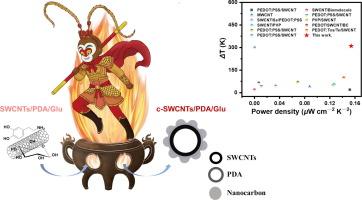Organic carbonization modification of carbon nanotubes with stable thermoelectric performance at high temperature
IF 13.3
1区 工程技术
Q1 ENGINEERING, CHEMICAL
引用次数: 0
Abstract
Carbon nanotube-based thermoelectric composites are promising sources in the field of flexible electronics. However, they often suffer from degraded thermoelectric performance at elevated temperatures due to their low thermal stability. In this study, highly-stable carbon nanotube-based thermoelectric composite at high temperature are fabricated through organic carbonization modification. Specifically, polydopamine is used as a linker to connect carbon nanotubes with carbonized glucose, forming a protective layer on the carbon nanotube surfaces. This protective layer serves a “two birds with one stone” purpose. On one hand, the carbonized glucose coating enhances the electron transfer characteristics at the surface of the carbon nanotubes, thereby improving the efficiency of electron transfer. On the other hand, it reduces the oxidation of carbon nanotubes in air at high temperatures, resulting in improved thermoelectric stability. The composite exhibits an excellent electrical conductivity of 1014.7 ± 40.1 S cm−1 and a Seebeck coefficient of 48.5 ± 1.6 μV K−1, achieving a PF of 238.5 ± 11.2 μW m−1 K−2 at 513 K. At 583 K (temperature difference 310 K), the power density can reach 0.156μW cm−2 K−2. This approach offers a novel pathway for designing and fabricating high-performance thermoelectric materials, providing valuable insights for future applications.

求助全文
约1分钟内获得全文
求助全文
来源期刊

Chemical Engineering Journal
工程技术-工程:化工
CiteScore
21.70
自引率
9.30%
发文量
6781
审稿时长
2.4 months
期刊介绍:
The Chemical Engineering Journal is an international research journal that invites contributions of original and novel fundamental research. It aims to provide an international platform for presenting original fundamental research, interpretative reviews, and discussions on new developments in chemical engineering. The journal welcomes papers that describe novel theory and its practical application, as well as those that demonstrate the transfer of techniques from other disciplines. It also welcomes reports on carefully conducted experimental work that is soundly interpreted. The main focus of the journal is on original and rigorous research results that have broad significance. The Catalysis section within the Chemical Engineering Journal focuses specifically on Experimental and Theoretical studies in the fields of heterogeneous catalysis, molecular catalysis, and biocatalysis. These studies have industrial impact on various sectors such as chemicals, energy, materials, foods, healthcare, and environmental protection.
 求助内容:
求助内容: 应助结果提醒方式:
应助结果提醒方式:


